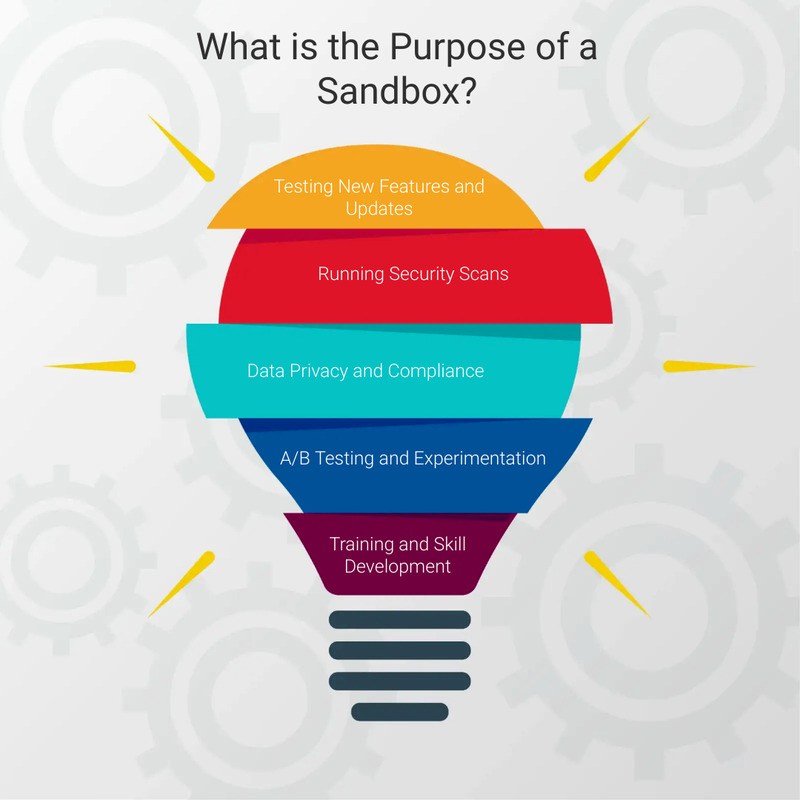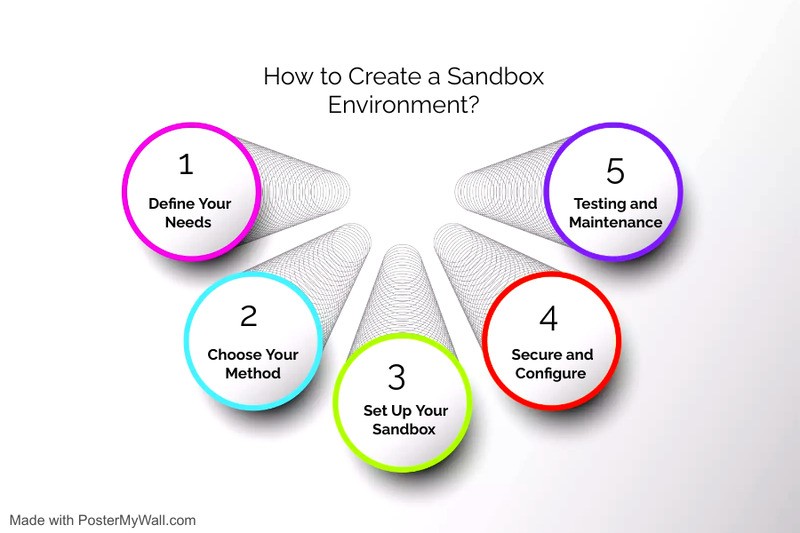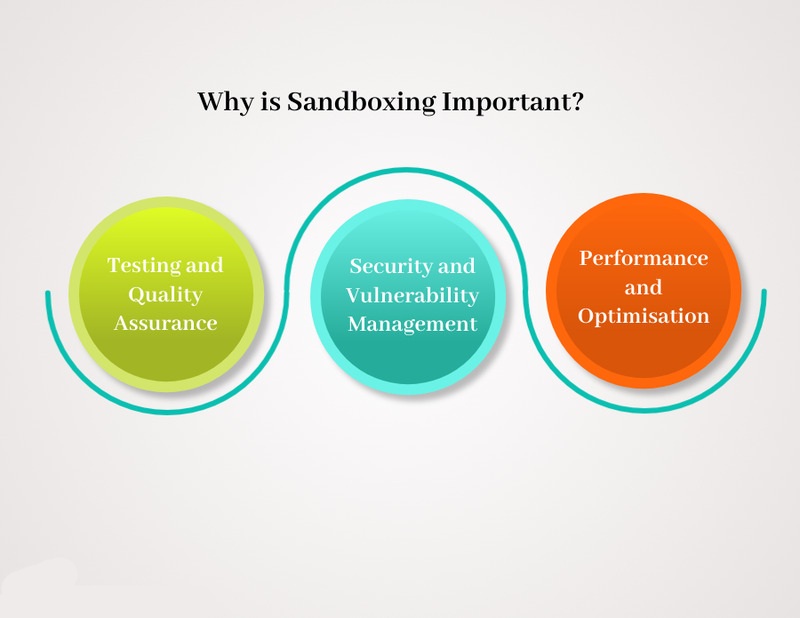Imagine a safe space to experiment, learn, and even break things without consequence. That’s what a Sandbox Environment is all about. It is a digital playground isolated from your main system where you can test new software, experiment with configurations, and tinker without causing harm.
In the dynamic realm of technology, testing is pivotal to ensure your website or mobile application security from bugs and potential threats before its final launch.
That’s where creating a sandbox environment proves to be a cornerstone for exploration and detection.
The Sandbox provides a simulated virtual space on the computer system for the developers to test and experiment with their software during the testing phase.
But, have you ever wondered how you can create your Sandbox Environment?
This comprehensive guide will walk you through the process of setting up your own sandbox environment, allowing you to unleash your creativity and enhance your skills.
Here, we’ll discuss everything you need to know to create your Sandbox, its purpose, and various benefits.
What is a Sandbox Environment?
“Sandbox” is metaphorically derived from a child’s Sandbox, where they can play and experiment with toys in a confined and secure area.
A sandbox environment is a controlled and isolated space, used both in web development and cybersecurity, where users can safely test, develop, and experiment with software, applications, configurations, or code without impacting critical systems or data.

Since it is a virtual space adjacent to the actual environment, developers and software testers are free to do trial and error tests without stressing on affecting the network components and programs running on the system.
In the context of a website testing, Sandbox provides a secure space where developers, quality assurance teams, and security professionals can conduct tests and experiments without affecting the live or production version of the website.
| Sandbox Environment Examples | ||
| Field | Examples | Description |
| Website & Software Development | Wix, Squarespace | Creates a separate environment to test updates without affecting the live website. |
| Cybersecurity | ThreatQuotient | Studies malware behaviour without risking real systems. |
| Cloud Computing | Kubernetes sandbox | Simulates a cloud environment for testing and optimising microservices. |
| Gaming | Minecraft | Allows players to test mods before adding them to the main game, preventing potential issues. |
| eCommerce Platforms | Shopify, WooCommerce | Merchants can test new products, features, and integrations in a separate environment without impacting their live store. |
Key Characteristics of a Sandbox
Key characteristics of a sandbox environment include isolation from production systems, the ability to control and configure various parameters, security measures to prevent unintended consequences, and the flexibility to reset or replicate the environment easily.

What is the Purpose of a Sandbox?
The purpose of a sandbox is to provide an isolated and controlled environment for testing, experimenting, and developing without impacting critical systems or data.
It gives a controlled and isolated environment for evaluating the functionality, performance, and security of websites during the development or testing phase. The key objectives of a Sandbox include:

- Testing New Features and Updates
Developers can create a sandbox environment to test new code, features, or functionalities before deploying them to the live website. This helps identify and fix bugs, ensure compatibility, and avoid disrupting user experience in the production environment. - Running Security Scans
Sandboxes can be used to isolate and scan potentially risky code, files, or external integrations before allowing them access to the main website. This helps mitigate security vulnerabilities and protect user data. - Data Privacy and Compliance
For websites that handle sensitive user data, testing in a sandbox environment helps maintain data privacy and comply with regulations. Synthetic or anonymised data can be used to simulate real-world scenarios without exposing sensitive information. - A/B Testing and Experimentation
Sandboxes can test different versions of a website’s layout, features, or content on a small group of users before changing the live version. This helps gather feedback and optimise the user experience. - Training and Skill Development
Sandboxes provide a safe space for developers and testers to practise and enhance their skills. It is an ideal environment for learning new technologies, testing methodologies, and debugging techniques without the risk of negatively affecting the live website.
| Sandboxing in Python?
Yes, you can definitely use sandboxing in Python! In the context of Python, a sandbox refers to a controlled environment created to execute Python code safely and securely. This environment restricts the code’s capabilities and access to system resources, preventing potential harm to your main system or data. |
How to Create a Sandbox Environment?
There are some traditional methods and technologies to create a Sandbox environment. The choice depends on the specific requirements of your project and the nature of the sandbox environment needed.
| Popular Technologies for Creating Sandbox Environment | ||
| Method | Description | Tools |
| Virtual Machines (VMs) | Creates a complete virtual computer within your existing system, offering isolation and high flexibility. | VirtualBox, VMware, Hyper-V |
| Containerisation (Docker) | Packages applications and their dependencies into portable containers, enabling faster deployment and isolation. | Docker, Docker Compose, Kubernetes |
| Cloud-Based Sandboxes | Utilises online services to provide pre-configured sandbox environments for various purposes. | BrowserStack, Sauce Labs, ThreatQuotient |
| Website/Application Specific Sandboxes | Platforms often offer built-in features or plugins to create isolated testing environments. | WordPress Staging Sites, Salesforce, Google Chrome Guest Mode, Browser Extensions like Sandboxie |
Therefore, the specific steps to create a sandbox environment depend on your chosen method and desired setup. However, to provide you with a general viewpoint, here we are giving you the information related to the framework and a step-by-step process to create a Sandbox Environment:

Step 1: Define Your Needs
The first step towards Sandboxing is clearly defining the purpose of your Sandbox (e.g., software testing, development, security research). Ask these questions from yourself:
- What do you want to achieve with the Sandbox? (Testing new features, security scans, etc.)
- What website platform are you working with?
- What level of technical expertise do you have?
To summarise, firmly identify specific objectives, such as testing new software, experimenting with configurations, or conducting security assessments.
Step 2: Choose Your Method
For Website-Specific Sandboxes
- Built-in Sandboxing Features: Check if your platform offers built-in sandboxing functionalities. For example, WordPress has a “staging site” feature, while Google Chrome offers a “guest mode” and extensions like “Sandboxie” for further isolation.
- Cloud-based Sandboxes: Platforms like BrowserStack or Sauce Labs offer pre-configured sandbox environments for various web browsers and devices.
- Custom Development: With advanced developer skills, you can create a custom sandbox environment using tools like Docker or virtual machines.
General Sandboxing Methods
- Virtual Machines (VMs): Powerful and customisable but resource-intensive. Popular choices include VirtualBox, VMware, and Hyper-V.
- Containerisation (Docker): Lightweight and portable, ideal for testing microservices. Requires some technical knowledge.
Step 3: Set Up Your Sandbox
The next crucial stage is when you are all set to set up your sandbox environment. To continue this step, install and configure the chosen platform on your host machine.
For website-specific sandboxes, the setup process might involve creating a separate account, installing a plugin, or subscribing to a service.
For VMs and Docker, expect to install and configure the software. Create virtual machines (VMs) or containers, allocating resources like CPU, RAM, and storage according to your requirements.
Step 4: Secure and Configure
Regardless of the method, ensure your sandbox environment is secure. Update software regularly, use strong passwords, and avoid unnecessary installations. For accurate testing, you must also configure the sandbox environment to mirror your website settings as closely as possible.
Therefore, to ensure security, follow the below procedures:
Security Measures
- Implement security measures to mitigate potential risks within the Sandbox.
- Set up firewalls and intrusion detection systems and regularly update the OS and software.
Network Configuration
- Isolate your Sandbox from the production network to prevent unintended interference.
- Configure networking settings within your virtualisation platform or containerisation tool.
Step 5: Testing and Maintenance
Once you complete the above steps, it is time to conduct initial testing of your web app or website to ensure the sandbox environment functions as expected.
Now, validate that your chosen tools ( IDEs, debuggers, testing frameworks, and any tools specific to your development or testing needs) and configurations meet your objectives.
Regular maintenance is vital after the testing and validation process to ensure that security measures and configurations are up-to-date.
Therefore, periodically review and update your sandbox setup to align with evolving needs and technology changes.
Use Resources for Further Information:
|
Why is Sandboxing Important?
Sandboxing is crucial during website development for several reasons. It provides a secure and controlled space for developers to innovate, test, and refine their work without compromising the integrity of the live system.
It is an integral part of the software development lifecycle, contributing to creating robust, secure, and high-performance digital products. Let us see the importance of Sandboxing below:

Testing and Quality Assurance
- Safe Testing: Sandboxes provide a safe and isolated environment to test new features, updates, and functionalities without affecting the live website. This minimises the risk of introducing bugs or breaking things in production.
- Early Bug Detection: By testing in sandboxes, developers can identify and fix bugs early in the development cycle. This saves time and resources compared to fixing them later in the process or after deployment.
- Thorough Testing: Sandboxes can simulate various scenarios and user behaviours, ensuring your website works flawlessly under different conditions. This helps deliver a high-quality user experience.
Security and Vulnerability Management
- Secure Code Testing: Sandboxes can test code for vulnerabilities before deploying it live. This helps prevent security breaches and protect user data.
- Third-Party Integration Testing: If your website integrates with third-party services, sandboxes can test these integrations in a controlled environment, ensuring they don’t introduce vulnerabilities.
- Continuous Security Monitoring: You can use sandboxes to monitor your website for security threats, allowing you to react quickly and mitigate potential risks.
Performance and Optimisation
- Performance Testing: Sandboxes can be used to test the performance of your website under different loads and conditions. This helps identify performance bottlenecks and optimise your code for a better user experience.
- Configuration Testing: Sandboxes allow you to test different configurations of your website to find the optimal settings for performance and resource efficiency.
- Scalability Testing: You can use sandboxes to test how your website scales with increased user traffic or data volume, ensuring it can handle growth reliably.
| Let us find out the Benefits and Limitations of Sandbox Environment | |
| Benefits | Limitations |
| Risk Mitigation: Isolation reduces the risk of unintended consequences during testing and experimentation. | Resource Overhead: Virtualization may impose higher resource requirements, impacting system performance. |
| Security Testing: Provides a secure space for analysing and understanding the behaviour of potentially malicious code. | Limited Realism: Sandbox environments may not perfectly replicate real-world scenarios, affecting testing realism. |
| Feature Development: Enables developers to experiment with new features and configurations without affecting live systems. | Performance Impact: Running websites in a sandbox may experience performance degradation compared to production. |
| Compatibility Testing: Provides a controlled environment for testing website’s compatibility across various platforms. | Learning Curve: Setting up and configuring sandbox environments may require a learning curve for new users. |
| User Acceptance Testing (UAT): Allows stakeholders and end-users to validate websites before deployment. | Data Management: Managing data in sandboxes, especially for complex websites, can be challenging. |
| Do you Know!
You can empower your website and elevate the functionality, security and overall performance using the latest Sandboxing Technology. Therefore, connect with an expert web building service provider and figure out the cost of building a website in Australia while implementing the advanced solutions. |
Conclusion
Establishing a sandbox environment for website development is no longer an optional luxury but a strategic necessity. It offers a safe space for experimentation, testing, and optimisation, ultimately leading to a more secure, reliable, and performant user experience.
Whether you leverage virtual machines’ power, containerisation agility, or cloud-based solutions’ convenience, sandboxing empowers you to iterate efficiently, enhance skills, and deliver high-quality websites.
However, the sandboxing technique is complex and needs a learning curve to ensure the best practices. Therefore, connect with a professional website designing company to get expert assistance in establishing paramount security for your web development project.













